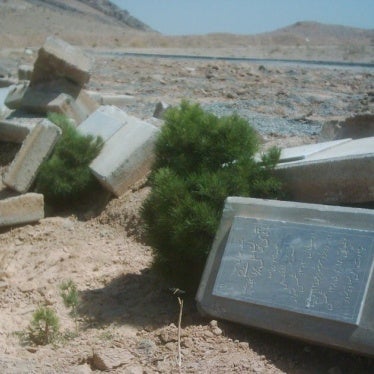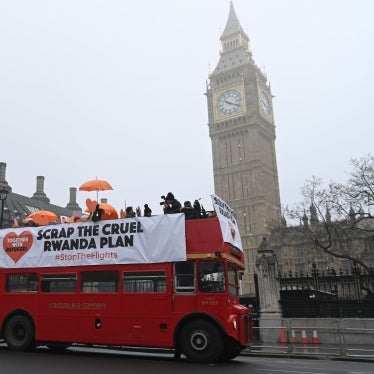H.E. Sergey V. Lavrov
Minister of Foreign Affairs
Ministry of Foreign Affairs
32/34 Smolenskaya-Sennaya pl.
119200, Moscow G-200
The Russian Federation
Dear Minister,
Over the past five years, Human Rights Watch has documented violations of humanitarian law by all parties to the conflict in Syria including indiscriminate and targeted attacks against civilians and civilian objects. In so doing, Human Rights Watch has consistently urged parties to the conflict, including the Russian Federation and the United States government, to promptly and thoroughly investigate credible allegations of civilian casualties in their military operations. When an unlawful attack causes civilian casualties, we urge governments to punish appropriately those responsible and provide compensation to the victims.
Since Syrian-Russian joint military operations began on September 30, 2015, Human Rights Watch has documented Syrian-Russian strikes that have hit civilian objects and resulted in civilian casualties. We have documented the Syrian-Russian joint military operation’s extensive use of internationally banned cluster munitions which we wrote to you about on August 10, 2016. We have also documented the increase in the use of incendiary weapons in Syria since Russian operations began there, with at least 18 documented attacks on opposition-held areas in Aleppo and Idlib between June 5 and August 10. In June, RT broadcasted footage of incendiary weapons—specifically RBK-500 ZAB-2.5SM bombs—being mounted on a Russian Su-34 fighter-ground attack aircraft at a Syrian airbase.
We write to you now, to share further evidence that we have compiled regarding sixteen aerial attacks that appear to have deliberately or indiscriminately hit civilians and civilian infrastructure, including bakeries, markets, and humanitarian objects between September 30, 2015, and September 19, 2016.
The evidence we have compiled is based on phone interviews with witnesses including residents, first responders, and medical personnel, a review of videos and photographic evidence.
All of these attacks occurred in opposition-held areas following the initiation of Russian-Syrian joint military operations, but the strikes cannot be confirmed as being committed by Russian forces. In a statement on May 9, the US and Russia promised to carry out a joint assessment of attacks in Syria “leading to significant civilian casualties” and to share the results with the members of the International Syrian Support Group Ceasefire Task Force and the UN Security Council. We believe as part of the Syrian-Russian joint operation in the bombardment of Syria, Russia has a responsibility to investigate these attacks which it may have been directly involved in.
We highly value your willingness to maintain an open communication channel with us and appreciate your response to our previous letter on the use of incendiary weapons.
We kindly request that the ministry provide us with responses to the questions included below regarding the attacks we have documented, and any other comments on specific policies governing Russia’s operations in Syria and Russia’s efforts to ensure its forces with international humanitarian law there.
- Based on what criteria does the Russian Federation determine to open an investigation into Russian airstrikes in Syria?
- Which domestic body is tasked with these investigations?
- Is the Russian Federation conducting investigations into Russian airstrikes in Syria that have allegedly killed or injured civilians? Are any of the strikes outlined below currently under investigation?
- How many open investigations are underway? Have any investigations been completed? What was the outcome of those investigations? When do you expect pending investigations to be completed?
- Through what mechanism is information regarding investigations recorded, stored, and tracked?
- Will the Russian Federation make public the results of its investigations?
- What steps will the Russian Federation take if its investigations determine that a violation of the laws of armed conflict from a Russian airstrike resulted in civilian casualties?
- Will Russia offer “condolence payments” to families of civilian victims in the event an investigation determines that a Russian airstrike resulted in civilian deaths or injuries?
- Has the Russian Federation sent warnings to civilians living in areas under or near Islamic State (ISIS) or Jabhat al-Nusra control to warn them of impending attacks?
- How is information being recorded to facilitate rapid marking, clearance, and removal of explosive remnants of war as required by Protocol V of the Convention on Conventional Weapons?
We ask that you send us your responses by December 20, 2016. Please direct all responses to my colleague Hadeel al-Shalchi at xxxx@hrw.org. She is also reachable at +961-xxx-xxx-xx.
As always, we remain available to speak with your staff at the ministry to discuss this matter and to answer any questions you may have.
Sincerely,
Lama Fakih
Deputy Director
Middle East and North Africa
Human Rights Watch
cc: Ambassador Alexey Borodavkin
Permanent Representative of Russia to the UN in Geneva
Listing of Alleged Unlawful Aerial Attacks
Attacks in Eastern Ghouta, Damascus
Ain Terma, October 13, 2015
The town’s main market was targeted twice, at 12:30 p.m. and at 2:30 p.m. on October 13, 2015, killing 15 people, including 2 children, and injuring 30 others according to first responders. Adnan al-Shami, a first responder, who rushed to the scene after the attack, told Human Rights Watch that he saw two people whose heads had been decapitated at the site, adding that the nearest frontline was at least seven kilometres away in Jobar, which, according to the Syrian Observatory for Human Rights (SOHR), was being shelled continuously and struck from the air between October 13 and 14. Bilal, a photographer who documented the attack, said there were many cases of amputations among the injured.
Douma, October 30, 2015
Around 8:00 to 8:30 a.m. on October 30, a Friday, an aircraft dropped at least four munitions on the market in al-Ghanam square, according to two local residents who spoke to Human Rights Watch. The attack killed at least 47 civilians, including eight children, according to the Syrian Civil Defense. Human Rights Watch also spoke to a photographer and a medical coordinator who both confirmed the attack. Two local residents told Human Rights Watch that the aircraft returned in the afternoon, around 4 p.m., dropping another four munitions on the market. The repeated attacks against the market suggest that it may have been intentionally targeted despite the absence of a military target in the vicinity of the market when it was hit. According to local residents the front line was four kilometers from the area hit and there were no military headquarters nearby.
Hamouriyeh, December 9, 2015
Around 2:00 p.m. on December 9, 2015, an aircraft dropped two munitions on shops and vendors while people were shopping for fruits and vegetables according to a medical source and a first responder. First responder Abdel Mo’in, who belongs to a Syrian Civil Defense unit that conducts search and rescue both in Kafr Batna and Hamouriyeh, said he heard planes overhead and arrived at the scene shortly after the attack. Mo’in told Human Rights Watch that at least 34 people were killed in the attack. He said that he saw at least 60 injured people at the nearest medical point, including many women and children. Footage posted by the Syrian Civil Defense on YouTube showed rescue workers going through rubble, looking for bodies and extinguishing fires. There is no sign of weapons or military equipment in any of the footage.
Arbeen, January 7, 2016
Aircraft attacked Arbeen’s marketplace in rural Damascus on January 7, 2016, killing 12 civilians including two women and one child, according to a first responder and a local photographer who talked with Human Rights Watch. Anas, a first responder with the Syrian Civil Defense, provided Human Rights Watch with a list of names of the deceased persons the Civil Defense pulled out of the rubble after the attack and those that died in local hospitals. He said that there were 13 strikes all over the town that day and one of them hit the marketplace. Dia al-Din, a photographer from Arbeen who later arrived to the site of the attack, said that the bombing lasted three hours. According to residents, Arbeen community members struck a deal with opposition forces to keep fighters away from the center of the town and restrict them to the front lines surrounding the town only.
Idlib
Kastan, October 30, 2015
Around 12 p.m. on October 30, an aircraft dropped at least two munitions on the market in Kastan according to a local journalist. Ahmad al-Bakeer, a media activist with the Syrian Civil Defense, who arrived at the market five minutes after the attack, told Human Rights Watch one child was under the rubble and that their main objective was to get her out, but after thirty minutes of digging, she died. According to the Syrian Civil Defense, the attack killed three people including two children. First responder Mohamed Khdeir said the market was at least 60 kilometres away from the closest front line and that the market had no military targets or headquarters.
Ma’arat al-Nu’man, November 2 & 8, 2015
Mustafa Gharib from the local Syrian Civil Defense said he was in the market in Ma’arat al-Nu’man buying goods when two airstrikes occurred around 12 p.m. on November 2, 2015. He and a media activist, who spoke to Human Rights Watch, said one woman was killed in the attack. Another aircraft attacked a second market on Abu al-Alaa al-Ma’ari street in Ma’arat al-Nu’man at around 5 p.m. on November 8 according to the Syrian Civil Defense killing 13 civilians. Gharib told Human Rights Watch that to his knowledge there were no military positions or headquarters in the markets at the time of the strikes and that after the Russian intervention in the war, the locals of Ma’arat al Nu’man asked all armed men to leave the city.
Saraqeb, November 29, 2015
At around 1:45 p.m. on November 29, 2015, an airstrike hit a bakery in Saraqeb according to an aid worker and a first responder. The bakery used to provide bread for 39,000 people in 24 villages free of charge according to Maruf, an IHH Turkish Humanitarian Relief staff member. He was told by mill workers who were present during the strike that the first strike hit the east side of the building which housed the mill. He said that the employees had fled hiding in trenches outside by the time the second strike hit and destroyed 80% of the building. A video published on December 4, 2015, on the Russian Defence Ministry’s YouTube page shows aerial footage of a building being hit by an airstrike. The title says that the video shows a Russian Federation airstrike on a large storage facility for fighters in Idlib. The open source research organization Bellingcat discovered that the building in the defense ministry video is the bakery near Saraqeb that was attacked. Leith Faris, a first responder with the Syrian Civil Defense, said that Syrian government forces struck the bakery several times before November 29. He said no one was killed or injured in the attack. Both Maruf and Leith Faris from the Syrian Civil Defense in Saraqeb said that there were no military targets near the mill when they responded to the scene, and that there was no evidence at the scene that the mill was used as a military storage facility.
Ariha, November 29, 2015 and January 26, 2016
Aircraft attacked a marketplace in Ariha in south of Idlib city on November 29, 2015 killing 40 people and injuring at least 100 according to a first responder and media activist interviewed by Human Rights Watch. The attack happened in the morning at around 9:00 a.m. One video showed several injured and bloodied people lying on the floor of a medical centre waiting to be treated. Another video showed scenes from what appeared to be a destroyed market with overturned crates of fruit and vendor tables. Mohammad Ghazal, a first responder, said that the mobile field clinic was overwhelmed with injured people. On January 26, 2016, aircraft struck the same marketplace according to Ghazal, killing nine people including one woman, and injuring 15. Ahmad al-Rihawi, a media activist, told Human Rights Watch that there were no military targets in the market and no military headquarters in it.
Idlib City, July 21, 2016
Aircraft attacked a three-story apartment building in al-Na’oura neighbourhood in Idlib City, according to Abu Hashem, a second floor resident who was present at the time of the attack. He said there were no military headquarters near the building. The strikes completely destroying the front of the building and killed his 23-year-old niece Reem, He heard planes flying overhead moments before the attack.
Idlib City, July 21, 2016
An aircraft struck the vegetable market in Idlib city on July 21, 2016, at 4:00 p.m. in the afternoon, according to Abu Najib, whose son was injured while on his way to shop in the market. He said that to his knowledge no military headquarters were present in the market.
Aleppo
Al-Atareb, November 17, 2015
At 11:30 p.m. on November 17, 2015, the bakery in al-Atareb was hit by an airstrike according to the bakery staff and the Syrian Civil Defense who responded to the strike. They told Human Rights Watch there were no casualties but that the attack disrupted the work of the bakery which served the city of Atareb as well as the rural countryside around it baking 25,000 bundles of bread a day. Abu Obada, deputy head of the Atareb bakery told Human Rights watch that there were no military targets or headquarters near the bakery.
Al-Salheen, December 9, 2015
An aircraft struck a residential building right next to a bakery in the Aleppo neighborhood of al-Salheen on December 9, 2015, killing 10 people, including two children and two woman, and injuring tens of others according to the Syrian Civil Defense, Syria Human Rights Committee and first responders who talked with Human Rights Watch. Naguib Fakhoury, an Aleppo first responder, said that there were many people waiting outside the bakery to receive bread. A munition hit a building near the bakery and the rubble fell on top of the queue of people. He said he “helped to pull out six people from the rubble and saw one girl die.” Abu Omar, deputy head of Aleppo Syrian Civil Defense, said he heard the planes as they swooshed overhead before dropping the munitions. He said they struck the three-story building. He said the closest frontline was five kilometers away. Video of the aftermath of the attack shows people picking up bread loaves from the ground amid great chaos and rubble dust. SOHR reported that heavy air raids were conducted on this date in Aleppo city and province as clashes continued between Syrian government forces and armed groups.
Al-Fardous, December 22, 2015
Aircraft struck a marketplace in the Aleppo neighborhood of al-Fardous on December 22, 2015, killing 11 people and injuring 40, according to first responders who helped with the rescue after the strike and a photographer who spoke to Human Rights Watch. Abu Omar, a first responder with the SCD who helped during the rescue mission of the Fardous market said the strike happened just after 9 p.m. According to first responders, the closest frontline is in an area called Sheikh Saeed about five kilometers from the market, and there were no military targets or headquarters in the market during the attack. Photographer Thaer Mahmoud said he was at home at the time of the strike but that when he went to the marketplace shortly after the attack and said he saw a chaotic scene with the Syria Civil Defense attempting to pull out many people from under rubble.
Al Sha’ar, July 10, 2016
An aircraft struck al-Sha’aar market on July 10, according to a mosque worker named Ali who was injured in the attack. Ali said he visited the market to pick up bread at 8:00 a.m. in the morning. He told Human Rights Watch that he heard planes circling overhead before the attack. He said there were no military targets or presence in the market at the time.
Kafr Naha, July 25, 2016
An aircraft struck a house located on the Tareeq al-Sham road in Kafr Naha on July 25, 2016, around 4 p.m., injuring a 7 years old boy called Mohamad al-Ali, according to his uncle. The uncle, also called Mohamad al-Ali, told Human Rights Watch that they heard warplanes overhead before a missile fell 6-7 meters from their house. There is no military base near the house, which is located in a field near a nut farm, according to Mohamad.
Urum al-Kubra, September 19, 2016
On September 19, 2016, airstrikes hit a United Nations aid convoy and a Syrian Red Crescent warehouse in Urum al-Kubra, killing one staff member in addition to twenty civilians, according to the UN Office for the Coordination of Humanitarian Affairs. Witnesses, including a journalist and a first responder, told Human Rights Watch that the attack was by air in an area only accessible to Russian and Syrian warplanes. Ahmad al-Ahmad, a local journalist, was in the area the night of the attack told Human Rights Watch that the warehouse was known to be a Red Crescent building and was far away from the warehouse was and far away from any front line or military headquarters. Ammar al-Salmo, a member of the Syrian Civil Defense, was also in the vicinity of the attack and told Human Rights Watch that the warehouse is on a highway and it is known to everyone in Urum al-Kubra and the area that this is a Red Crescent warehouse and there are no military bases around it. Human Rights Watch reviewed more than 10 photos of the aftermath of the attack that showed injured and dead civilians, huge fires engulfing buildings, damaged trucks filled with what seemed to be food and other supplies, and people showing logos of the Red Crescent and UN agencies on damaged supplies.








